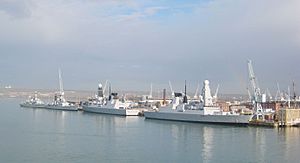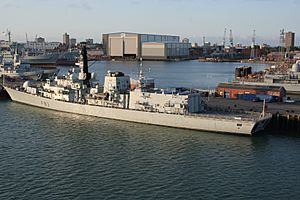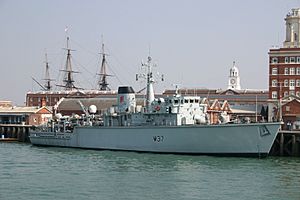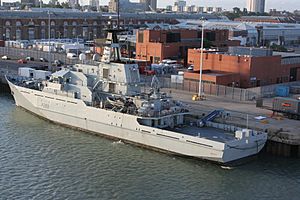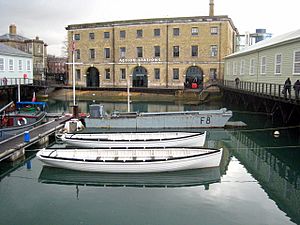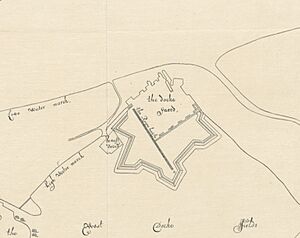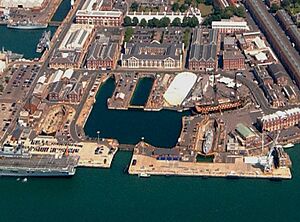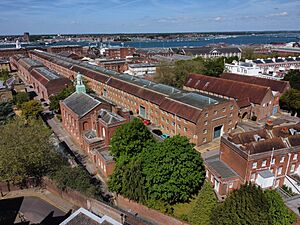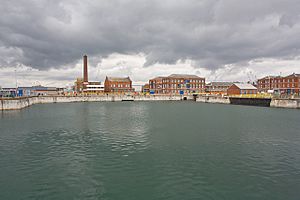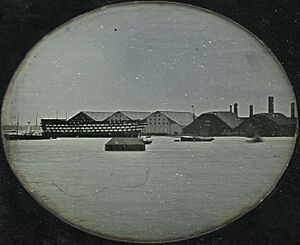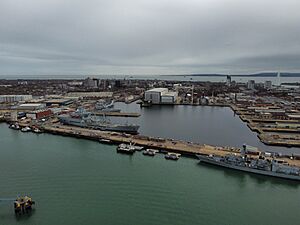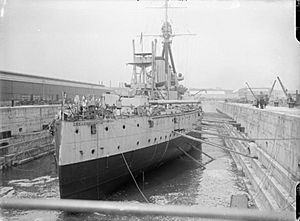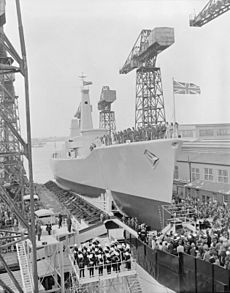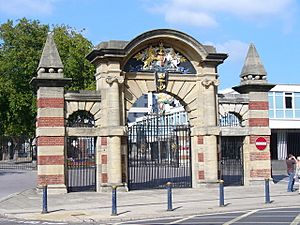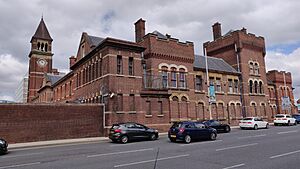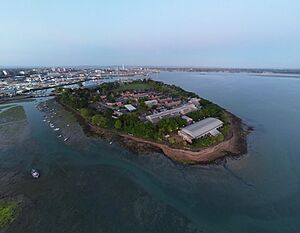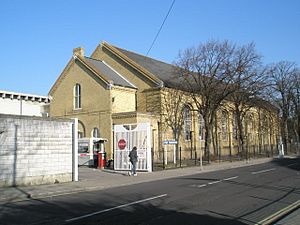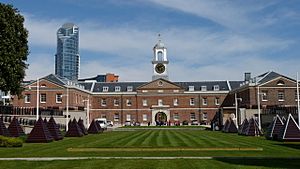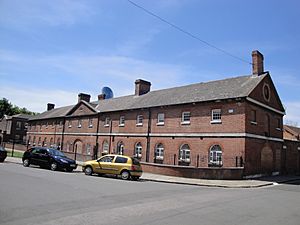HMNB Portsmouth facts for kids
Quick facts for kids HMNB Portsmouth
|
|
|---|---|
| Portsmouth, Hampshire, England | |
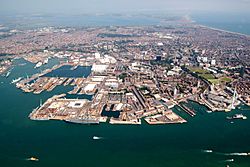
An aerial view of HMNB Portsmouth taken in 2005
|
|
|
Location in Hampshire
|
|
| Coordinates | 50°48′15.91″N 1°6′8.71″W / 50.8044194°N 1.1024194°W |
| Type | Naval base |
| Area | 122 hectares (300 acres) |
| Site information | |
| Owner | Ministry of Defence (Defence Equipment and Support) |
| Operator | Royal Navy |
| Controlled by | Naval Base Commander, Portsmouth |
| Condition | Operational |
| Site history | |
| Built | 1194 |
| In use | 1194–present |
| Events | International Festivals of the Sea (1998, 2001 & 2005) |
| Garrison information | |
| Current commander |
Commodore John Voyce OBE |
| Garrison | Portsmouth Flotilla |
His Majesty's Naval Base, Portsmouth (HMNB Portsmouth) is one of the main homes for the Royal Navy in the United Kingdom. It is located in the city of Portsmouth, on the eastern side of Portsmouth Harbour. For a long time, it was known as HM Dockyard, Portsmouth. It was a huge place for building, fixing, and looking after warships. At one point, it was the biggest industrial site in the world!
Since the 1970s, it has been called a 'Naval Base'. This means it focuses more on supporting the people and ships, not just building them. In 1984, the shipbuilding part was made much smaller. It was then called the 'Fleet Maintenance and Repair Organisation'. This part became a private company in 1998. Building new ships stopped in 2014.
Today, Portsmouth is the home for most of the Royal Navy surface fleet. This includes the two giant aircraft carriers, HMS Queen Elizabeth and HMS Prince of Wales. The base provides everything the Navy needs, like food, places to sleep, and medical care. Other Navy offices are also located here. Private companies also work at the base, helping to fix and maintain ships.
This base is the oldest in the Royal Navy. It has been a very important part of Britain's history for hundreds of years. It has one of the oldest drydocks in the world. The old Portsmouth Block Mills were the first factory to use steam-powered machines to make many things at once. The Royal Naval Museum has been here since 1911. Part of the historic area is now the Portsmouth Historic Dockyard. Here, you can visit famous ships like the Mary Rose, HMS Victory, and HMS Warrior. You can also visit the National Museum of the Royal Navy, Portsmouth.
Contents
Portsmouth Naval Base is home to about two-thirds of the Royal Navy's surface ships. Around 17,200 people work here.
Who is in Charge?
The person in charge of the Naval Base is called the Commodore John Voyce. He has been the Naval Base Commander since June 2022. The harbour itself is controlled by the King's Harbour Master (KHM). This person makes sure all ships move safely in and out of the port. Their office is in the Semaphore Tower building.
Since 2012, the First Sea Lord uses HMS Victory as their special ceremonial ship. This means it is a symbol of their command.
Ships Based at Portsmouth
Some of these ships are part of the Portsmouth Flotilla. This means they are managed from Portsmouth, even if they are not always docked there.
Famous Old Ships
Aircraft Carriers
These are the Royal Navy's largest warships. They can carry many aircraft.
- HMS Queen Elizabeth
- HMS Prince of Wales
Type 45 Destroyers
These are powerful warships designed to protect other ships from air attacks.
- HMS Daring – getting fixed, back in 2024
- HMS Dauntless
- HMS Diamond
- HMS Dragon – getting fixed, back by end of 2024
- HMS Defender – getting a big upgrade until 2026
- HMS Duncan
Type 23 Frigates
These ships are used for many different tasks, like hunting submarines and protecting convoys.
- HMS Lancaster (currently in Bahrain for 3 years)
- HMS Iron Duke (finished a big repair in 2023)
Hunt-class Minehunters
These ships are specially designed to find and destroy sea mines.
- HMS Ledbury
- HMS Cattistock
- HMS Brocklesby
- HMS Middleton – works from Bahrain
- HMS Chiddingfold – works from Bahrain
- HMS Hurworth
River-class Patrol Vessels
These ships patrol coastal waters and protect fishing areas. Some are deployed around the world.
- HMS Tyne – Fishery protection
- HMS Severn – Fishery protection
- HMS Mersey – Fishery protection
- HMS Forth – in the Falklands since 2019
- HMS Medway – in the Caribbean since 2020
- HMS Trent – from Gibraltar since 2021
- HMS Tamar – in the Indo-Pacific since 2021
- HMS Spey – in the Indo-Pacific since 2021
Cutlass-class Patrol Vessels
These small patrol boats are used by the Gibraltar Squadron.
- HMS Cutlass
- HMS Dagger
Archer-class Patrol Vessels
These ships are used by university naval training units.
- HMS Blazer
- HMS Exploit
- HMS Puncher
- HMS Ranger
- HMS Smiter
Experimental Ship
- XV Patrick Blackett (since 2022) – used for testing new ideas in the Navy.
Dive School Boats
- 3× Sea-class 15 metre diving support boats.
Portsmouth Historic Dockyard
The Portsmouth Historic Dockyard is a special part of the base that is open to visitors. Here you can see:
- The Mary Rose: a Tudor warship that sank in 1545 and was raised in 1982. You can see her in a special museum building.
- HMS Victory: Nelson's famous flagship from the Battle of Trafalgar. You can go on board and explore.
- HMS Warrior (1860): The first large iron warship, built in 1860.
- HMS M33: A World War I monitor ship, opened to the public in 2015.
- The National Museum of the Royal Navy, Portsmouth: A museum with many exhibits about the Royal Navy.
- Action Stations: A fun centre with interactive displays about naval science and simulators.
- The Dockyard Apprentice exhibition: This tells the story of the dockyard and the people who worked there.
- Portsmouth Harbour Tours: Boat trips around the harbour.
- Boathouse 4: This building tells the story of the Navy's small boats. It is also a place where boats are built and fixed.
Portsmouth has been one of the most important Royal Navy bases for a very long time.
Early Days
Richard I started building the first dock here in 1194. Later, King John added walls around the area in 1212. Kings used these docks when they went to fight in France.
Tudor Times

The first recorded dry dock in the world was built in Portsmouth by Henry VII in 1495. The first warship built here was the Sweepstake in 1497. More famous ships like the Mary Rose (1509) and Peter Pomegranate (1510) were also built and rebuilt here. The Mary Rose sank in 1545 and was brought up in 1982.
After the mid-1500s, no new warships were built here for a while. However, ships from Portsmouth helped fight off the Spanish Armada in 1588.
The 1600s
Shipbuilding started again in Portsmouth in 1648. The first ship was the Portsmouth. A new large dry dock was built in 1656. The dockyard also got a new rope house (where ropes were made).
Between 1665 and 1668, Bernard de Gomme built strong earth walls around the dockyard to protect it.
Amazing Engineering by Dummer
As France became a bigger threat, Portsmouth became even more important. In 1689, a new dry dock was ordered. It needed to be big enough for the largest warships. This work started in 1691. It was a huge project, building on land that used to be mud flats.
The engineer Edmund Dummer designed this new dry dock. It was built with brick and stone, which was a new idea. This dock is now known as No.5 dock.
Dummer also suggested building two wet docks (basins where the water level stays the same). The first one is still there today and is called "No. 1 Basin". He also created a clever system to empty the dry dock using water power.
The 1700s
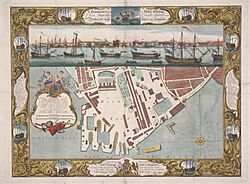
Between 1704 and 1712, a brick wall was built around the Dockyard. Much of this wall is still standing. In 1733, the first Royal Naval Academy for officer training was opened here.
The Great Rebuilding
From 1761, the dockyard was greatly expanded and made more modern. This was because ships were getting bigger and the Navy was growing. New dry docks were built, and old ones were improved.
Many important historic buildings in Portsmouth Dockyard are from this time. Large brick storehouses were built between 1764 and 1785. A deep canal was also built so ships could load and unload goods.
The Great Ropehouse, a very long building where ropes were made, was built around this time. It was called 'double' because two parts of the rope-making process happened in the same building.
Samuel Bentham and the Industrial Revolution
In 1796, Samuel Bentham was put in charge of modernising the Royal Dockyards. He brought in new ideas and machines. He even designed the first successful steam-powered bucket dredger to clear the harbour.
Bentham also designed new stone dry docks (Nos 2 and 3 docks), which are still used today. He used a new type of waterproof cement. He also designed a special "ship caisson" to close off the entrance to the basin.
In 1797, Bentham suggested using a steam engine to drain the docks and power machinery. This was the first time steam power was used in a Royal Naval Yard.
Between two large workshops, a special building was constructed in 1802. This became the world's first steam-powered factory for mass production: Portsmouth Block Mills. Marc Brunel, a famous engineer, designed the machines that made ships' pulley blocks.
The 1800s
By 1800, the Royal Navy had 684 ships. Portsmouth Dockyard was the biggest industrial place in the world. In 1805, Nelson visited the new block mills before sailing from Portsmouth on HMS Victory for the last time.
Victorian Dockyard Expansion
When warships started using steam propulsion, the dockyards had to change a lot. In 1843, work began to create a new 7-acre basin (now No 2 Basin) in Portsmouth. A large factory was built next to it to make marine steam engines.
Three new dry docks were built over the next 20 years. The shipbuilding slips were also covered with large metal roofs.
The Great Extension
Ships also started being built with metal hulls instead of wood. This meant ships could be much bigger. So, in the late 1850s, plans were made to expand the dockyard even more. From 1867, three new connected basins were built. Each basin had a different purpose, like repairing ships or getting them ready to sail.
Two large locks were also built to enter the basin complex. A nearby pumping station helped drain these docks and power equipment. This "Great Extension" was mostly finished by 1881.
The Dockyard Railway
In 1843, a railway system was started inside the dockyard. By 1952, there were over 27 miles of track! It was used less in the 1970s and closed in 1977.
A small railway station was built in 1876. It was used by Queen Victoria and her family when they moved from their yacht to the train.
The 1900s
By the early 1900s, the dockyard was still growing. New workshops and facilities were built.
Dreadnoughts
The first modern battleship, Dreadnought, was built here in just over a year (1905–06). Many more dreadnoughts followed, like Bellerophon and Queen Elizabeth.
The dockyard also got electricity in 1906. A new, very large factory was opened in 1907 to fix and maintain steam turbine engines.
The biggest Navy ships were now too large for the old basins. So, the walls between the basins were removed to create one large body of water (No 3 Basin). Two new, very long entrance locks (C & D locks) were built in 1914. These are still used today.
First World War
During World War I, the largest ship launched at Portsmouth was the battleship Royal Sovereign in 1915. Many other ships were repaired here. Over 2,100 women worked in the dockyard during the war, many in jobs usually done by men.
Between the Wars
After the war, the dockyard became smaller. Many people lost their jobs. New warships launched here included cruisers like Suffolk and London.
In 1922, HMS Victory was moved into No 2 Dry Dock, where she is today. She was opened to the public in 1928. A museum about her was opened nearby ten years later.
Second World War
Portsmouth Naval Base was very important during World War II. It was heavily bombed by the Germans.
On D-Day, 6 June 1944, Portsmouth was the main starting point for military and naval units going to Sword Beach in Normandy. Many ships, including those carrying troops and the special Mulberry Harbours, left from Portsmouth.
After the Wars
After World War II, many damaged buildings were rebuilt or removed. The dockyard was busy fixing and modernising ships. However, in 1969, a plan was made to reduce the size of the Navy and the dockyard workforce.
In 1981, the government announced that shipbuilding would stop at Portsmouth. The workforce would be cut a lot. However, this was put on hold when the Falklands Conflict started.
Falklands Task Force
In 1982, Argentina invaded the Falkland Islands. A large group of British military and merchant ships, called a task force, was sent from Portsmouth to take the islands back.
The task force included:
- Two aircraft carriers
- Many destroyers and frigates
- Submarines and patrol ships
- Supply ships and tankers
- Many merchant ships, like Queen Elizabeth 2
Most of these ships returned to Portsmouth later that year.
Changes to the Dockyard
After the Falklands War, some of the planned cuts were changed. More workers were kept at Portsmouth. However, some old dry docks were closed, and many cranes and workshops were removed.
In 1998, the work of fixing and repairing ships was given to a private company called Fleet Support Limited.
The 2000s
In 2005, Portsmouth Naval Base hosted two big events for the 200th anniversary of the Battle of Trafalgar. These were the International Fleet Review and the International Festival of the Sea.
Shipbuilding and Repair
Shipbuilding started again in 2003. A new facility was built to construct parts of warships, like for the Type 45 destroyers and Queen Elizabeth-class aircraft carriers. However, in 2013, it was announced that shipbuilding in Portsmouth would close.
BAE Systems still manages ship repair and maintenance at Portsmouth. The old shipbuilding complex is now used for fixing smaller ships like minehunters.
New Aircraft Carriers
In 2013, a £100 million project began to prepare the naval base for the new Queen Elizabeth-class aircraft carriers. The harbour was made deeper so the huge ships could enter and leave safely. Jetties were strengthened to allow both carriers to dock at the same time. HMS Queen Elizabeth arrived in Portsmouth in 2017, and HMS Prince of Wales followed two years later.
The person in charge of HMNB Portsmouth is called the Naval Base Commander.
- 2011–2012: Commodore Tony Radakin
- 2012–2018: Commodore Jeremy Rigby
- 2018–2019: Commodore Jim Higham
- 2019–2022: Commodore Jeremy Bailey
- 2022–present: Commodore John Voyce OBE
In 1899, the Navy bought some old army barracks and built new Naval Barracks. Before this, Navy personnel in Portsmouth lived on ships. The barracks opened in 1903 and were called HMS Victory. They were renamed HMS Nelson in 1974.
Some of the original buildings are still there, like the canteen, the drill hall, and the officers' mess. The nearby prison is now home to the Royal Marines School of Music.
The Dockyard led to many other Navy and military sites being built around Portsmouth. Here are some of them:
- HMS King Alfred: A Royal Naval Reserve unit in the renovated Semaphore Tower.
- HMS Excellent: On Whale Island, this is a training base for the Navy.
- HMS Temeraire: In Portsmouth, this is where Navy Physical Training Instructors are trained.
- HMS Collingwood: In Fareham, this is a training establishment for naval warfare.
- HMS Sultan: In Gosport, this is a training centre for mechanical and electrical engineering.
- Institute of Naval Medicine, Gosport.
- HMS Dryad: Now a police and guarding school.
- HMS Dolphin: An old submarine base, now Fort Blockhouse.
- HM Gun Wharf, later HMS Vernon: An old torpedo and mines base, now a shopping and leisure area called Gunwharf Quays.
- HMS Daedalus: An old Fleet Air Arm base.
- Royal Naval Hospital, Haslar: An old naval hospital.
- Eastney Barracks: Former Royal Marines barracks, now housing.
- Forton Barracks: Former Royal Marines barracks, now St Vincent College.
- Royal Clarence Victualling Yard, Gosport: An old supply yard.
- RNAD Gosport: A site with old gunpowder and ammunition stores, now including Explosion! Museum of Naval Firepower.
Military Fortifications and Barracks
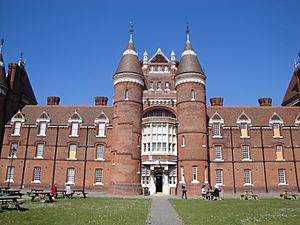
The Fortifications of Portsmouth were built over many centuries to protect the fleet and dockyard. These included defensive walls and forts.
Many barracks were built around the city to house soldiers. By 1900, these included:
- Cambridge Barracks: Now part of Portsmouth Grammar School.
- Clarence Barracks: Old artillery barracks.
- Hilsea Barracks: Old army barracks, now housing.
- Milldam Barracks: Now part of the University of Portsmouth.
- Point Barracks: Old artillery barracks.
- St George Barracks, Gosport: Old transit barracks for troops.
- Victoria Barracks: Old infantry barracks.





